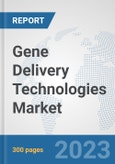Gene delivery technologies are essential for various applications in research, medicine, and biotechnology, such as gene therapy, genetic engineering, and studying gene function. Gene delivery technology can further be classified into viral-based, non-viral-based, and combined hybrid systems. Viral-mediated gene delivery systems utilize modified viruses that are rendered replication-deficient but still capable of delivering DNA for gene expression. Commonly used viral vectors include retroviruses, lentiviruses, adenoviruses, and Adeno-associated Viruses (AAV). Non-viral gene delivery systems were created as a substitute for viral-based systems, offering an alternative approach to delivering genes into target cells. Furthermore, rising genetic and inherited diseases among the population across the globe are supporting the growth of the market during the forecasted period.
Viral gene delivery systems are anticipated to maintain their dominant position in the delivery systems segment of the gene delivery technologies market. These systems have undergone extensive research and development for gene therapy applications, establishing themselves as the preferred choice for delivering genes into target cells. By utilizing viral vectors like adenoviruses, lentiviruses, and Adeno-associated Viruses (AAVs), viral gene delivery systems efficiently transport therapeutic genes into cells. These vectors are carefully modified to ensure the safe and effective delivery of the desired genetic material. The viral-based approach offers several advantages, including high transduction efficiency, the ability to target specific cell types, and the potential for long-term gene expression. These qualities have contributed to successful clinical applications of viral gene delivery in various diseases.
North America has been a significant presence of the key players in the gene delivery technologies market, particularly due to the extensive number of clinical trials conducted in the region. The United States, in particular, has been at the forefront of gene therapy research and development. Gene therapies hold great promise for offering potential treatments for various diseases caused by genetic mutations or degeneration, including cancer, HIV/AIDS, and genetic disorders. The United States has seen a significant number of clinical trials focused on evaluating the safety and efficacy of gene therapies for these conditions. Furthermore, many companies in the field of gene therapy have prioritized the supply and commercialization of gene therapies and technologies, with a particular emphasis on the major organizations and headquarters located in the United States. This has contributed to North America's leadership in the Gene Delivery Technologies market.
Report Findings
1) Drivers
- Increasing genetic and inherited diseases among the population drive the growth of the market.
- The growing demand for targeted therapeutics propels the growth of the market.
2) Restraints
- The adverse effect related to gene therapy hampers the growth of the market.
3) Opportunities
- The rising investment in Research and Development (R&D) is a crucial factor that presents a significant opportunity for the market.
Research Methodology
A) Primary Research
The primary research involves extensive interviews and analysis of the opinions provided by the primary respondents. The primary research starts with identifying and approaching the primary respondents, the primary respondents are approached include1. Key Opinion Leaders
2. Internal and External subject matter experts
3. Professionals and participants from the industry
The primary research respondents typically include
1. Executives working with leading companies in the market under review2. Product/brand/marketing managers
3. CXO level executives
4. Regional/zonal/country managers
5. Vice President level executives.
B) Secondary Research
Secondary research involves extensive exploring through the secondary sources of information available in both the public domain and paid sources. Each research study is based on over 500 hours of secondary research accompanied by primary research. The information obtained through the secondary sources is validated through the crosscheck on various data sources.The secondary sources of the data typically include
1. Company reports and publications2. Government/institutional publications
3. Trade and associations journals
4. Databases such as WTO, OECD, World Bank, and among others.
5. Websites and publications by research agencies
Segment Covered
The global gene delivery technologies market is segmented on the basis of delivery system, mode, application, and method.The Global Gene Delivery Technologies Market by Delivery System
- Viral Gene Delivery Systems
- Non-viral Gene Delivery System
- Combined Hybrid Delivery Systems
The Global Gene Delivery Technologies Market by Mode
- AAV
- Lentivirus
- Retrovirus
The Global Gene Delivery Technologies Market by Application
- Gene Therapy
- Cell Therapy
- Vaccines
- Research
The Global Gene Delivery Technologies Market by Method
- Ex Vivo
- In Vivo
- Others
Company Profiles
The companies covered in the report include- Thermo Fisher Scientific Inc.
- Oxford Biomedica
- SignaGen Laboratories
- Synbio Technologies
- SIRION Biotech
- Novartis AG
- Bio-Rad Laboratories, Inc
- OriGene Technologies, Inc.
- Promega Corporation
- Others
What does this Report Deliver?
1. Comprehensive analysis of the global as well as regional markets of the gene delivery technologies market.2. Complete coverage of all the segments in the gene delivery technologies market to analyze the trends, developments in the global market and forecast of market size up to 2030.
3. Comprehensive analysis of the companies operating in the global gene delivery technologies market. The company profile includes analysis of product portfolio, revenue, SWOT analysis and latest developments of the company.
4. Growth Matrix presents an analysis of the product segments and geographies that market players should focus to invest, consolidate, expand and/or diversify.
Table of Contents
Companies Mentioned
- Thermo Fisher Scientific Inc.
- Oxford Biomedica
- SignaGen Laboratories
- Synbio Technologies
- SIRION Biotech
- Novartis AG
- Bio-Rad Laboratories, Inc
- OriGene Technologies, Inc.
- Promega Corporation








